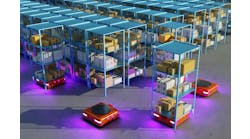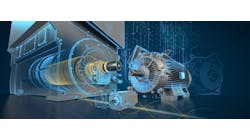By Jim Montague, Executive Editor
Why do overnight successes always take at least 10 years? For instance, it’s been just over a decade since Waterford Township Public Works (twp.waterford.mi.us/publicworks) installed variable-frequency drives (VFDs) on the high-service, constant-speed motors at its 11 drinking water plants in Michigan (Figure 1). Terry Biederman, Waterford’s public works director, says, “Opto 22’s PLCs and RTUs control these VFDs from Danfoss, Square D and Robicon. The VFDs use flow-matching to eliminate transients that were contributing to about 80 water main breaks per year, and reduced the breaks to 15 to 20 per year. This saves hundred of thousands of dollars in repair costs each year.” However, there was more good news to come.
A Softer, Smarter Touch
As with so many other control and automation disciplines, ever faster, cheaper and more powerful computing has enabled VFDs to be applied in more and smaller settings. So where oil and gas, pulp and paper, and a few other big-ticket processes used to be the only applications able to afford widespread use of VFDs and controls, they’ve more recently been popping up in water/wastewater, food and beverage, pharmaceuticals, consumer products and many lower-profile facilities.
“Using drives and motor controls, especially AC VFDs, gives us better control of each drive, so we can handle glass with a softer touch, for example, or do a better job applying labels. VFDs also allow us to better manage our energy consumption with supply, instead of running our pumps at full speed all the time and having to put in recirculation loops,” says Scott Richards, project manager and electrical engineer at Polytron, an Atlanta-based process-and-packaging system integrator (SI). “In the mid-1990s, the large suppliers focused on large, stand-alone, 5 hp to 10 hp VFDs with custom HMIs and mass-produced drives. Now we can call our distributor and get 5 hp to 10 hp VFDs that we can plug in and program on-site.”
In the past five to seven years, Richards adds, the biggest leaps in drives and motor controls have been networking and intelligence. “So when we put in a linear distribution system, all the separate devices that we used to have are now linked by Ethernet,” he says. “And having Ethernet connectivity in 50 networked drives means we can program them in advance, look at current draws in real time and do more preventive maintenance. Added intelligence means VFDs can report when there’s a problem, such as when they’re likely to fail soon. We also can program VFDs to do periodic diagnostic checks. It’s like having a room of college graduates instead of a room of third graders.
“More powerful, less costly computing also makes it more economically feasible to have intelligence at smaller points along a production line or process. For example, a continuous oil-and-gas process can monitor its in-line flow and density, provide the data about what’s going through its pipe via DeviceNet and Ethernet, and if its running slow, take back instructions to check the upstream filter. We can even set up a web page, so remote users can do real-time monitoring at one-tenth of the previous cost, and use this shop-to-top connectivity to squeeze 3% to 5% more production out of their process.”
A History of Support
Though drives and motor controls don’t occupy quite the starring role in process settings as they do in discrete manufacturing, they still support essential functions, such as pumps, fans and other rotating devices that all processes require. Many motors used to run at or close to full power, so flows were controlled by damping or valves. Consequently, just as production lines benefited from increasing motor efficiency and drive/control intelligence, many process applications came to use variable-speed control and PI loops in drives for better continuous control.
“In the past 10 years, drives and motor controls have become more sophisticated and less costly. Low-voltage drives went into all kinds of applications and were connected to integrated architectures, communications systems and added safety and security features,” says Sean Gaffney, Rockwell Automation’s AC drives marketing manager. “These days motor-control hardware is tied into communication networks, and drives are integrated for better diagnostics and control. Our Premier Integrator software makes it easier to integrate drives with our controller. Lockout programs are available for added security, and many drives now respond to safety inputs.
“In addition, VFDs and controls can save energy because the energy consumed by a motor is proportional to the cube of its speed. So in centrifugal pumps and fans, a small change in speed can give you a big energy savings (see sidebar) because of the drag that occurs as the pump or fan pushes through whatever fluid it’s processing. Some U.S. states require VFDs for motors over certain voltages, while some users, especially in water/wastewater applications, requiring harmonic migration, which involves sending less electrical noise to the grid.”
Gaining Green
In another eco-friendly effort, Lockheed Martin is using Schneider Electric’s Telemecanique 5-hp to 250-hp VFDs tied to Rockwell’s Allen-Bradley CompactLogix PLCs to run two 600-hp, 300-psi biomass-fueled steam boilers in its helicopter and flight control plant in Oswego, N.Y. The boilers will burn waste wood and supplement the plant’s oil and gas boilers, which supply the plant’s HVAC and controlled-environment facilities, including temperature and humidity controls, liquid nitrogen pressure in its test chambers and several product inspection sites.
“A lumber mill down the street processes 200 tons of logs per day, and since 48% of each log is still scrapped, we’ll get about 95 tons per day of chips and sawdust,” says Michael Magill, Lockheed’s site energy program manager. “Because waste wood is one-half to one-third the cost of oil or gas, we’ll be able to cut that portion of our energy bill in half and save $125,000 to $150,000 per month.”
Rick Kirkpatrick, Baldor Electric’s variable-speed drives product manager, adds, “VFDs have always been able to take on varied roles, but recently they’ve become dependable and reliable enough—and energy costs have gone up enough—for them to be used in even more process applications, and because VFDs allow you to vary the speed of an AC motor using PLCs, many added benefits have emerged as motors have become efficient. For example, in pumps or fans bearing quadratic or centrifugal loads, using a VFD means you don’t need to deliver full power to the motor to save a lot in energy costs. Now, as the motor slows, we even have automatic energy optimization routines in the drives, and these can automatically adjust power and voltage to reach an optimal point.”
Mark Kenyon, marketing manager for ABB’s low-voltage AC drives, adds that coordinating multi-drives fed from a DC source can help save power because using 100-hp motoring and 100-hp braking won’t use up power losses in the form of heat, as happened in the past. Instead, multi-drives allow feed power back into their application and so recover 95% of the power cut into transmission.
Future Features
“We’ve been using inverse-gate, bipolar transistors for very fast, 16,000-Hz on/offs, and I think we’re now up to about 30-hp drives on a DIN rail,” says Kenyon. “HMI and SCADA software and other interfaces to drives have taken the user experience from using screw-drives to change switches to programming drives like a cell phone or iPod. Network capabilities have gone from discrete inputs and pulling six power leads and 12 controls leads at $150 each to two-wire fieldbuses, and now to Ethernet and to wireless in the future. Finally, PLC functions in eight I/O blocks have been added to many drives, so users can just program a drive instead of a PLC.”
Drives, Motor Controls Aid Process, Eco-Friendly Apps
Users are implementing smart drives and motor controls in a wide variety of process-related and environmentally friendly applications. Here are some of the most interesting:
- To maintain steady pressure and flow in backwash funnels in the dionization/regeneration section of its Tulsa, Okla.-based water bottling facility, Culligan uses PID functions in Baldor Electric’s H2 inverter drive. So when water demand slackens, the drive goes into sleep mode, and when pressure drops below a setpoint, the drive wakes and tells the motor and pump to re-pressurize the pipe. This occurs in a seamless transition, so operators can fill one to 32 of Culligan’s 8-oz to 5-gal containers more quickly and consistently. “Before this new setup, we had to walk 300 feet back and forth to start and stop our motor, and the pressure in the pipe was only a good guess,” says Chip Pierce, Culligan’s operations VP.
- Calgary, Alberta-based Q’Max Solutions’ patented mud-stripping water-recycling process removes solids from drilling water in oil and gas wells. The water lubricates the drill bit’s cutting action and cleans the well bore, and is then pumped back to the surface with up to 25% solids that must be removed before the water is used again. Q’Max’s clarification tanks and pump systems reduce wastewater by 50%, and then use Baldor’s H2 drives to monitor return flow to the well. The drives also adjust pump speed to maintain proper flow rate, which can change dramatically depending on the rock type being drilled through. “If we didn’t have these drives, operators would be opening and closing valves all day long as the flow rates change, and the pumps could run dry or lag behind and overflow the tanks,” says Lorne Onstad, Q’Max’s general manager.
- To help load and position 2,000-ton barges, Wintech in Shreveport, La., employs Baldor’s 18H vector drives to run dual winches in its barge-moving systems at Liter’s Quarry Terminal in Louisville, Ky., and at Mulzer Stone in Tell City, Ind. The drives provide smooth acceleration/deceleration, infinitely variable line speed and controlled back tension on the trailing winch. Jim Leslie, Wintech’s president, proposed replacing the mover’s former hydraulic system with vector drives, and Dallas-based system integrator M-Tech helped design the solution. The vector drives eliminated the need for tug boats and needed only one of two former operators to control the pulling winch and the tensioning winch.
- Lewis Corp. of Pocatello, Idaho, and Bollinger Enterprises, North Warren, Pa., recently developed their 42-ton Bollinger Briquette Press, which converts coal dust into industrial briquettes, while also reducing pollution from mining and power applications. The press mixes the dust with a binding agent and then compresses it in large drums powered by Baldor’s 5011 Frame 300-hp, eight-pole motors. The resulting briquettes can be sold to mining companies or electrical utilities for fuel.
Slightly Slower = Big Energy Savings
Centrifugal loads, such as those on pumps and fans, offer the greatest potential for energy savings when operating at less than 100% of required flow or pressure conditions, says Dale Basso, of Baldor-Dodge-Reliance in Greenville, S.C., in his presentation “Energy Team Meeting: Energy Savings with AC Motors.”
For example, a 100-hp induction motor running at 100% speed and 100% load will cost $27,139 per year to run, according to the following formula: (100 hp) x (1/95% eff.) x (.746 kw/hp) x (.08 $/kWh) x (12 h/day) x (360 day/year) = $27,139.
However, the same 100-hp induction motor running at 60% speed and 22% hp will cost $5,970 per year to run, according to the same parameters: (100 hp) x (0.22) x (1/95% eff.) x (.746 kw/hp) x (.08 $/kWh) x (12 h/day) x (360 day/year) = $5,970.
Consequently, the resulting savings of $21,169 per year occur because affinity laws for motors reduce the horsepower required to run a motor by the cube of its speed. In this case, 0.60 x 0.60 x 0.60 = 0.216.




